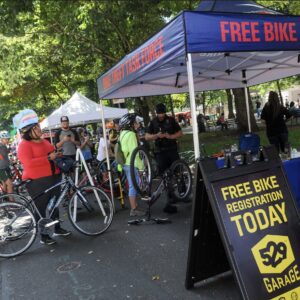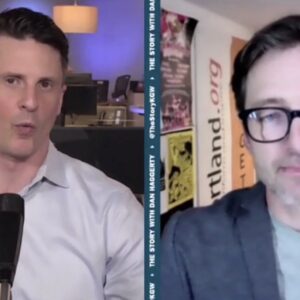On Wednesday, the TriMet Task Force on Safety and Service Excellence released its final list of recommendations. The task force was put together following a tragic incident back in April where a TriMet bus operator drove into five people in a crosswalk in downtown Portland, killing two of them.
Here’s an excerpt from the cover letter to the report written by task force Chair (and former TriMet GM) Tom Walsh,
“The tragedy of April 24, 2010, drove the direction and intensity of the task force’s work. This fateful occasion was clearly the darkest night in TriMet’s history. The focus of our recommendations is to help you migrate TriMet to the highest level of safety performance, so that such an event never happens again.”
Four recommendations stood out for me (there were 19 total):
- bringing about a culture change around safety in the agency,
- no longer using the term “accidents,”
- creating an Executive Director of Safety position,
- and a focus on “hot spots.”
The task force urged TriMet to change their culture around safety — from just another thing on the checklist, to a core value of everyone in the agency. To hasten this change, the task force recommended improved communication and engagement both internally and with the community at large.
Interestingly, the task force acknowledged the importance of language and word-choice in influencing agency culture. From the report:
TriMet should eliminate the term “accident” from its vocabulary to the extent practicable, and instead use words that are descriptive of the event in order to highlight the predictable and preventable nature of most collisions and injuries.
I’m very happy that this made it into the report. If TriMet adopts this recommendation, they could lead the way with local agencies and organizations taking a more serious stance on language. (I’d also like to see the Portland Police Bureau, PBOT, and the BTA follow suit with a similar review of language use).
An Executive Director of Safety that reports directly to the GM is another recommendation in the report. Having one person dedicated to “breaking down silos” can do wonders for communication in a bureaucracy like TriMet.
The focus on “hot spots” is perhaps the most encouraging recommendation on the list. After our story on Monday about the Transit Mall, and ongoing concerns in general about how bicycles are mixing with buses, cars, and MAX trains it, I was happy to see it specifically called out. Here’s the excerpt from the report about “hot spots”:
TriMet should use data to determine where safety “hot spots” may exist or are likely to develop over time, and take a systematic approach to evaluating and treating such “hot spots.” Based on employee comments to the Task Force, the Portland Transit Mall is a “hot spot” in need of review.
Such a review would require working with partner organizations to address the relationship
between three spheres of influence over safety on the street: (1) the operator and bus
equipment; (2) the roadway, track way and related infrastructure; and (3) other users, such
as cyclists, pedestrians and motorists.
These recommendations are a good road map to improved safety at TriMet; But they are just recommendations at this point. Hopefully in the coming weeks and months TriMet will adopt some of them.
Here are a few more links to more info about this report:
— Why didn’t the task force recommend putting cameras on buses and trains to film operators? Portland Afoot tells us why.
— Portland Afoot’s comprehensive wiki page entry on the task force.
— More coverage about the report in The Oregonian
— Read the full report via Google Docs (thanks to Portland Afoot for uploading it!).






In response to the sentence, “I’d also like to see the Portland Police Bureau, PBOT, and the BTA follow suit with a similar review of language use”, the Bicycle Transportation Alliance strongly believes that accident should not be used. In fact, this recommendation was brought by me at the Task Force. It is not only language that we are addressing, it is the perspective that some crashes were unavoidable that was alarming. I am encouraged that this recommendation made the final report.
Thanks for that Rob.
Just so you know, I was referencing other language issues — not just “accident” — with that call out to you guys and PBOT.
It’s a separate issue that needs its own post to flesh out… but, I’d really like the BTA and PBOT to pledge to stop using mode-first labels. I feel it is unneccessary and detrimental to our work when terms like “Bicyclist” “cyclist” “pedestrian” “motorist” etc.. are used.
I don’t want to derail this thread with all my thoughts about language, but thought your comment warranted clarification from me.
thanks again.
Jonathan: As I’ve made abundantly clear, I disagree with your assessment of how safe the bus mall is for cyclists. I’d argue that so long as cyclists put themselves in the middle of the one available lane (not on the edge of the lane and not in the bus/MAX lane) they’re as safe as they can be anywhere in the city. This assumes that they ride legally and in a predictable manner. The combination of slow traffic speeds and lack of lane changes/merges makes it a slow but safe place to bike.
cyclist,
thanks for explaining your opinion about that so thoroughly. In response, I’ll say that in my opinion, the issue of the mode mix on the transit mall isn’t just about safety… it’s about efficiency and how it functions overall for the city.
While it could be argued that 5th and 6th aren’t as efficient as they could be, Trimet’s review isn’t about efficiency, it’s about safety. Per your quote:
TriMet should use data to determine where safety “hot spots” may exist or are likely to develop over time…. Based on employee comments to the Task Force, the Portland Transit Mall is a “hot spot” in need of review.
Clearly Trimet thinks the bus mall is a *safety* hot spot, and is evaluating it as such. As previously stated, I strongly refute such statements. In the article text you seemed to support it.
Hey, thanks a lot for the nod, Jonathan. Glad to help get the committee’s important work out there.
Jonathan,
We’ll hear more from Neil McFarlane at next week’s board meeting about how this report will turn into action.
We’ll be talking further about how to approach the “hot spot” review, recognizing that such a review about the Mall will require input from a wide range of folks.
I am interested in the concern over mode-first labels, and if this isn’t the place, would like to hear more about it. I assume it is similar to person-first language when talking about people with disabilities.
Josh Collins
TriMet Operations
It is true, safety has to be at the top of the list and as my training suggests, error on the side of safety or if it isn’t safe, don’t do it. The way we think is very important and helping others to understand just how important safety is the challenge. I know that I have to keep this the number 1 priority, in the forefront of all the other distractions that occur each and every second while driving my bus. Suggesting that accidents should be dropped as terminology is a good step, because it is an accidents is like saying I’m sorry repeatedly and continuing the same action that got you there. Collision is a more definitive word to use because we want to avoid colliding with anyone or anything and most of us do, every time we get behind the wheel. The safety training that is provided has to be informative and a occur regularly so that it remains the #1 priority. It not only has to be the operators #1, but all the way to the top of the chain of command, because they have to look at the bigger picture of numbers etc. IMHO the higher ups could use the same kind of safety training and maybe even take ride with an operator once in a while to be reminded just what it is like behind the wheel of a 20 ton bus.
Here’s an observation.
Over the last 10 years, I’ve probably contacted TriMet 4 times regarding dangerous encounters with buses. They’ve always asked whether I’d like to be contacted for a follow-up. I’ve always said yes.
Never have they followed up. This is a systemic failure.
Cyclist #3 makes good valid points. As long as there are no lane changes bicycles should be pretty safe on the bus mall. If they don’t put themselves in a position to get hurt/ passing when there is not really a lane for that… they should be fine. The dude that passed the turning bus and got squashed put himself in danger and lost.
unrelated to this post but still worth mentioning is “drive throughs”. If you are in line at a drive through on your bike, there is a chance the guy behind you will roll into you while he is trying to get his money out, i have had this happen in my car numerous times. It is a liability issue for a fast food place, they could get their socks sued off.
I’m glad to see the transit mall highlighted as a hot spot. How about a reality check on what it’s like to ride a bike on the transit mall?
I think the transit mall is a good case to prove the shortcomings of sharing the lane. It makes it a lot harder for everyone, and so far people are not coping very well.
As a cyclist on the transit mall, I get all the risks and none of the benefits.
Taking the lane does not give me a feeling of safety when I’m sandwiched between anxious drivers. My helmet won’t save me in this case.
I don’t feel safe shoved up against the curb either.
As a cyclist I don’t get to benefit from the synchronized lights because mostly I get stuck behind lines of cars waiting for pedestrians. See sandwich above.
The cars often tailgate me or want to merge in from the bus lane where they’re not supposed to be in the first place.
There are cases where sharing the lane works, but this is by far the worst example. Mixing modes like certainly does not improve the feeling of safety, let alone actual safety.
I’m in favor of reserving the transit mall completely for transit, and optionally for a dedicated bike line. The full mode mix is not a pleasant one.
“As long as there are no lane changes bicycles should be pretty safe on the bus mall.”
Motorists often enter the wrong lane and then realizing their mistake move back into the left-most lane. And the few time I’ve ridden 6th during rush hour I saw very few cyclists take the lane. I did see many of them weave in an out of confused/stalled traffic. IMO, the transit mall is dangerous, confusing, and terribly inefficient. It should be transit only.
In Paris and other cities they let bikes and busses share lanes. No cars allowed though.
I think that near miss follow ups are essential to preventing future accidents. I know that in my industry for every 600 near misses of a given type, there are 60 First Aid accidents, 6 Time loss accidents (where a person is transported to a medical facility) and one fatal accident. So that means that prior to the fatalities last winter 600 similar failures had occurred.
Now I am not privy to the safety investigation, but whatever the causes (poor routing? driver fatigue?), had they been addressed before hand this would not have happened. For me a big part of my job is going out and seeing how things are done in the “real world”. Often AHA plans are written up in a way that is not applicable to every possible situation- this can make the safety plan irrelevant and eventually ignored. The answer is to apply a safety program, observe it in operation and then adjust the plan as necessary to cover unforseen situations. Also having field safety monitors will ensure that all drivers are following the basic safety rules.
spare_wheel #11: So what you’re saying is because some cyclists ride in a dangerous way (“I did see many of them weave in an out of confused/stalled traffic”) we should ban bikes from the bus mall? I’ve been stuck waiting for a car to turn left off of 6th. It’s easier and safer if you just wait (like the rest of auto traffic). If I’m in a hurry I take 4th instead, but I don’t think there’s a safer street downtown with the possible exception of Park (though you have parked cars to contend with).
BTW, cyclists ride like idiots all over town and drivers drive like idiots all over town. We can do our best to mitigate bad behavior, but at some point we just have to lay the blame where it belongs, on the people making the stupid decisions.
As a daily bike commuter and a TriMett employee who did outreach to peds and cyclists on the Mall some cyclists simply ignored our requests to stay left of the transit lanes. Personally I find traveling by bike on 5th and 6th to be much slower than 3rd, 4th and Broadway. I am interested in thoughts on how to persuade riders this is a good idea.
Tri Met should not be telling us where to ride our bikes in the bus mall or anywhere else.
They are “supposed” public transportation.
I personally feel that the handling of cyclists on the bus malls by Tri Met, now and in the past, has been like dealing with a bully in the school yard.
The best thing to do is laugh and go about your business, regardless of what the bully says.
When we have a supposed public transportation system policing our streets, we have a real problem on our hands.
We should start a task force to take care of that problem…….
“TriMet should eliminate the term “accident” from its vocabulary to the extent practicable, and instead use words that are descriptive of the event in order to highlight the predictable and preventable nature of most collisions and injuries.”
Okay, this is absurd. Eliminating the term ‘accident’ will not solve anything. Everything is an accident. Do you think a transit operator would really crash their vehicle on purpose? I think not. I realize some things may not seem like accidents, but all in all they are. Thats simply the nature of events.